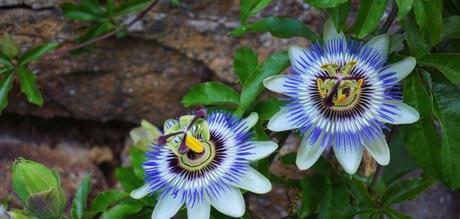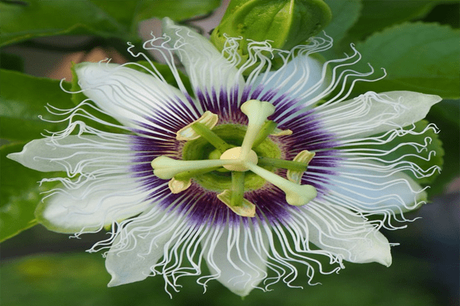
Introduction
Passiflora: In the 15th century, Spanish missionaries in Peru coined the term Passiflora. He saw this unusual flower as a symbol of crucifixion- The Passion of Christ. Its five petals and 5 sepal arrangement give the appearance of 10 apostles of Jesus Christ (excluding Judas and Peter), five anthers represent the five sacred wounds of Jesus Christ, 3 stigma represent the 3 nails which held the Jesus on cross, tendril of flowers resemble the whips used in flagellation and the filament resembles the crown of the thorns.

Description
It is a perennial vine. The Stems are long, trailing, smooth or pubescent; possessing many tendrils. Its leaves may be 3-lobed or 5-lobed. Petals are bluish-white in color with white and purple corona. Flowers are self-sterile and are often pollinated by Bumblebees and Carpenter bees, fleshy fruit is an oval-yellowish berry, of the size of a hen egg having many seeds. The fruit has scanty pulp in it with a sweetly tart taste. Its color is green at first but it changes to yellow when it matures. It is mainly found in thickets, near riverbanks, near unmowed pastures, roadsides, disturbed areas, and railroads, with lots of available sunlight. It is not found in shady areas.
Cultivation
It is easily cultivated and is native to the southeastern United States extending into the central portion of the US reaching Illino is Indiana and Ohio. The plants grow in well-drained sandy soil and in sunny areas. It can be planted all year in zone 7-11 ( hardiness zone). The plant seeds in the spring season.
Traditional Use
It is used to heal cuts and bruises. It is used as a powerful nervine tonic to treat stress and anxiety.It has also been used traditionally to provide relief to women who are experiencing menopause symptoms such as hot flashes and insomnia.
Latin Name - Passiflora FoetidaFamily - Passifloraceae
English Name - Passion Flower, Maypop, Wild-Passion-Fruit, Love-In-A-Mist
Classification
Kingdom - Plantae
Family - Passifloraceae
Genus - Passiflora L.
Common Name - Mukkopeera
Habitat - South America
It is widely used in Ayurveda and alternative medicinal practices as a natural herb and it potentially resolves various health issues.
Useful Part
- Leaves and stems are very useful
- The whole plant is very useful
- At the end of summer, a gathering of aerial parts of the plant is done.
The Action of Passiflora on Our Body
Each part of the plant possesses the specific property and has specific pharmacological action on our body.
- It has antidepressant, anti-inflammatory, hypnotic, antispasmodic, anti-anxiety, mildly sedative, powerful anti-oxidant
Chemical Composition
Passiflora contains traces of indole alkaloids which include Harman as the main constituent along with Harmine and Harmaline constituents, tiny percentage of maltol and it also contains various flavonoids up to 2.5 percent.
Indications
It is used in cases of neuralgic pains associated with debility, nervous headache, hysteria, generalized seizures, convulsive movements, oppressed breathing, spasmodic asthma, irritation of brain and nervous system, exhaustion from cerebral fullness, Sleeplessness due to overwork, tetanus, infantile nervous irritation, nervous tachycardia, cardiac palpitation or insomnia.
Therapeutic Classification Index
It has following therapeutic benefits on the Central nervous system, Digestive system, and musculoskeletal system -
- Central Nervous System - It reduces stress. Its fruit contains Hydrogen Cyanide (HCN)which is useful in treating headaches and insomnia. It is the herb of choice for treating insomnia.
- Digestive System -Fruit is emetic in nature.
- Musculoskeletal System - In moderate doses, it acts as an anti-spasmodic with somewhat narcotic nature.
Passiflora as a Sedative
It is a good rest producing agent. It is useful in restlessness and to overcome wakefulness. It is used in cases of insomnia occurring in infants and old people. It is useful in headache or sleeplessness that occurred due to overwork. It relieves the nervous system and provides peaceful and restful sleep to the patient and on the next day the patient awakens refreshed and quite.
Passiflora as an Antispasmodic Herb
It is very useful in the neuralgic type of pain. It has shown good results in relieving rectal pain, cardiac pain, spasmodic and neuralgic dysmenorrhea, facial neuralgia. It is also associated with or not associated with spasmodic action. It is also proved useful in many reflexes painful conditions incidents with menopause and pregnancy. It is also beneficial in nervous headache, cerebral fullness and also the headache of debility.
Use of Passiflora in Convulsions
It is proved to be very useful in convulsive disorders. It has shown very good results in treating tetanus, occurring in both man and horse. In case if any warming sign of convulsion occurs to you, then, in this case, it is given in full doses as in this condition this remedy proves to be of considerable value, but once the attack has started then it is of no use. But it has shown good results in treating all stages of convulsions. It has shown good control in spasms occurring in childhood, irrespective of the reason, whether due to worms, due to dentition or due to any undigested ailment. In 1896, Dr. Holmes reported a case of post-partum puerperal eclampsia in which a patient had two convulsions before but by the hypodermatic use of two drachms of Passiflora (Passiflora Incarnata), the patient got relief. It has proved to be successful in hysteria with spasmodic movements along with whooping cough in association with convulsions.
Preparation and Dosage
It is available in Powder, Capsule and Liquid form -
1. To Treat - Insomnia
Infusion - Take 1 Cup boiling water, then add 1 teaspoon of dried Plant. Leave it for 5-10 minutes to infuse then strain. Take One Cup at bedtime.
2. To Treat - Palpitations, Nervous Agitations, and Vegetative Dystonia
Infusion - Take One Cup - Three times a day.
Tincture - (1:8 In 25% Alcohol) - Take 25 drops in a glass of Water - Three times daily.
Cautions
No side effects have been reported till now if used in therapeutic doses.
Shubhra Krishan
